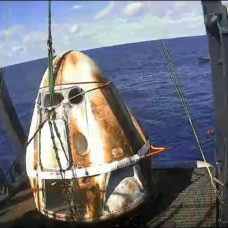In the center of the Milky Way hides a supermassive black hole known as Sagittarius A *.
At a size of four million solar masses, the intense gravity of Sgr A * makes all matter in the vicinity, including millions of stars, fall into the mouth of this cosmic monster and never come back out.
Though difficult to see, astronomers are working on ways to get past the dense cloud of gases and dust that’s blocking our view. Some researchers are currently tracking the powerful relativistic jets of Sagittarius A* to construct sharp images of the galaxy’s heart.
But, at 26,000 light-years away, we still can’t make much of what’s going on in the Milky Way’s core.
The Milky Way’s Center Under a VR Lens
Thanks to NASA VR visualizations, we can make it easier to decipher what’s happening with this black hole and his hidden brethren.
In November 2018, we got a first glimpse at a NASA VR movie that shows the supermassive black hole of the Milky Way.
Now, the agency has released another NASA VR visualization that immerses you in the place of Sagittarius A* in the galaxy’s center.
Take your seat in the center and turn around in any direction you want to see stars, clouds of gas and dust and swirling cosmic winds, all with a rich palette of colors.
According to NASA’s Chandra X-ray Center, the:
“360-degree video of the Galactic Center is ideally viewed through virtual reality (VR) goggles, such as Samsung Gear VR or Google Cardboard. The video can also be viewed on smartphones using the YouTube app. Moving the phone around reveals a different portion of the movie, mimicking the effect in the VR goggles. Finally, most browsers on a computer also allow 360-degree videos to be shown on YouTube. To look around, either click and drag the video, or click the direction pad in the corner”.
Without further ado, here’s the video:
To make this visualization, they combined simulations obtained using NASA Ames Research Center supercomputer with observations data from the Chandra X-ray space observatory.
One of Chandra’s main missions is to track the activity in the center of the galaxy. NASA’s Pleiades, at Ames Research Center (California), is one of the world’s most powerful supercomputers that allows for the creation of complex simulations.


















Comments (0)
Most Recent